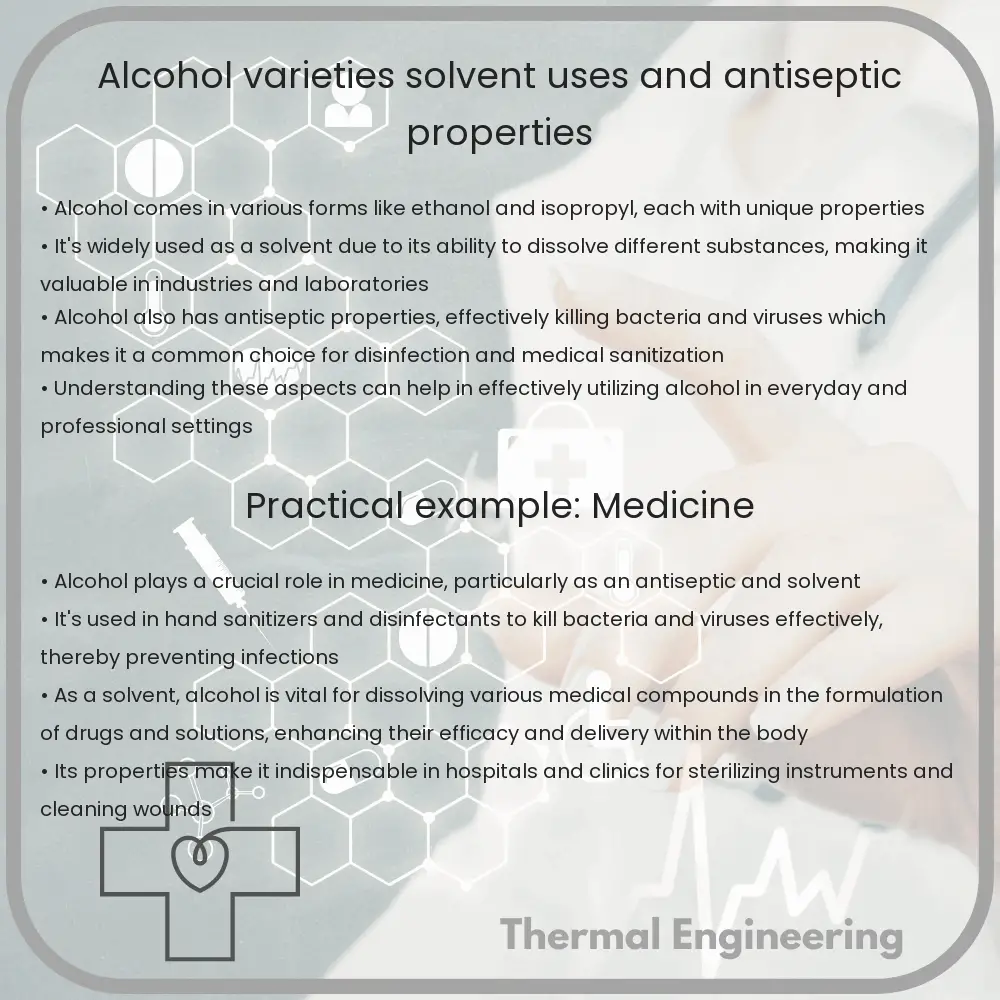Learn about the various types of alcohol, their uses as solvents in different industries, and their effectiveness as antiseptics in medical settings.

Understanding Alcohol: Varieties, Solvent Uses, and Antiseptic Properties
Alcohol is a versatile and widely used chemical compound, known scientifically as ethanol or ethyl alcohol. Its chemical formula is CH3CH2OH. Coming in various forms, it serves numerous applications across different fields such as medicine, industry, and personal care. This article breaks down the types of alcohol, their uses as solvents, and their effectiveness as antiseptics.
Varieties of Alcohol
The term ‘alcohol’ covers a broad spectrum of compounds, but the most common types include:
- Methanol (CH3OH) – Also known as wood alcohol, it’s the simplest form of alcohol and is used mainly as a solvent or antifreeze.
- Ethanol (CH3CH2OH) – Commonly used in alcoholic beverages, it is also employed in medical settings and as a solvent due to its non-toxic nature.
- Isopropanol (C3H8O) – Often used as a disinfectant or a solvent, it’s more commonly known as isopropyl alcohol or rubbing alcohol.
- Butanol (C4H10O) – Used in the manufacture of varnishes and as a solvent in the pharmaceutical industry.
Solvent Uses of Alcohols
Alcohols are regarded highly for their effectiveness as solvents due to their ability to dissolve both polar and nonpolar substances. This makes them incredibly useful in various applications:
- Pharmaceuticals: Ethanol and butanol are frequently used to manufacture medicines, helping to dissolve active ingredients for tablet production or liquid medications.
- Cosmetics: Alcohols like isopropanol are used in the production of lotions, perfumes, and aftershaves where they help mix oily substances and water.
- Industrial Cleaning: Methanol and isopropanol are powerful agents for cleaning electronic components because of their ability to evaporate quickly without leaving residue.
- Paint Industry: Butanol is frequently utilized as a solvent in paint thinners and removers, aiding in the application and removal process.
Antiseptic Properties of Alcohols
Alcohol’s antiseptic properties are one of its most valued uses, particularly in medical and personal hygiene contexts:
- Disinfection: Ethanol and isopropanol are effective in killing microorganisms on skin and surfaces. They are commonly used in hand sanitizers and disinfecting wipes.
- Sterilization of Tools: Isopropyl alcohol is used to sterilize medical instruments and surfaces in healthcare settings due to its effectiveness against bacteria, viruses, and fungi.
Alcohol functions as an antiseptic by denaturing proteins in microbial cells, effectively destroying them. The optimal concentration for this activity is typically around 70% alcohol in water. Higher concentrations can be less effective as they tend to coagulate the protein surface, protecting the microbe’s inner structure.
Conclusion
Alcohols, in their various forms, serve many essential roles across different industries. Their abilities to act as solvents enhance the production processes in pharmaceuticals, cosmetics, and paint manufacturing. Moreover, their antiseptic properties make them indispensable for maintaining hygiene and preventing the spread of disease in medical and home settings. As common as they are critical, alcohols continue to be a cornerstone in science and daily life alike.